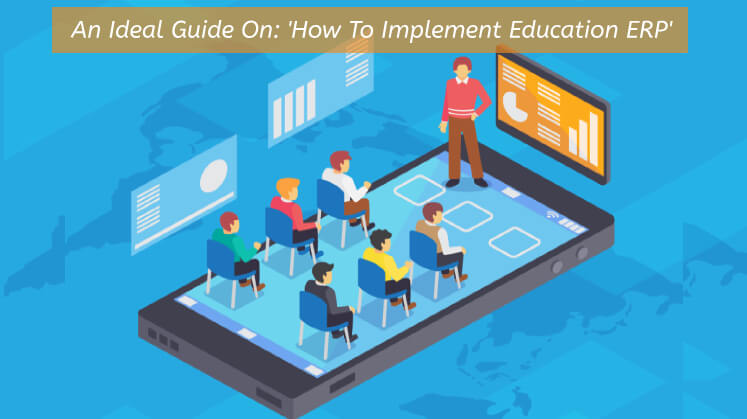
A campus management software is a cohesive single system which harnesses data systematically, organizes it and produces it in a required format on demand. The benefits of deploying a suitable ERP especially in an educational institution are potent, effective and long-lasting. But for an ERP to produce optimum results, it must be implemented in an integrated, compatible and systematic manner.
The consequences of an improper implementation of an education management software could affect its productivity, profitability and hamper the processes carried throughout the campus. As a result the organization may face some losses because reversing the damage may take a lot of time and may require many changes which may or may not be affordable. Also, any mistake could have grave effects on students which cannot be afforded hence, a precise, instructive guide to implementing ERP in education sector must be perused before taking any decisions.
Following is a step by step procedure illustrating how an education erp implementation is performed by MasterSoft:
Demonstration
The first and one of the most important part is demonstration which is to be conducted before procurement. The basic structure of each constituent of the erp module is explained by our professional. Its recommended that the management as well as the end users should be present on-site as they are the ones working with the erp. Important points are noted and doubts are cleared at this stage. The team simultaneously studies and gets a hold of the institutional processes and the same are marked down to improve the functionality of the system. The specific requirements, if any, are asked to be put forward by the institution and the same are mapped.
Installation
Once the PO is received, an ERP variant which best suits the organization,s requirements is assembled keeping in mind all the statistics and details gathered during demonstration. Based on user experience and business intelligence tools a robust, reliable and integrated erp is installed in as short as a week. To induce the necessary tempo and ardor to improve user cooperation, a detailed demonstration of different modules is given to the designated module incharge by the onsite team. While the support team works on the changes suggested by the user.
Detailed Gap Analysis
In the next 3 weeks, module experts closely observe and figure out the institutional processes minutely and gather their respective gaps. During this analysis, sample data is collected by the onsite team and accordingly masters are configured. The institution is asked to give their own insight while configuration is being done as any change can easily be made at this stage. Once the configuration is completed successfully the subsequent required reports are formulated. A module wise SRS (software requirement specification) is prepared by the team which has to be approved by the users.
Customizations
Minor changes are done simultaneously with the above steps as and when the need arises. Whereas, major changes (if any), require written institutional approval. Customization which changes the coding of the software is done in such a case. The original software is tailored to comply with the actual ongoing processes of the institution as close as possible to obtain the desired results in the most efficient, holistic and profitable way. Customization fine tune the software which in turn meets every requisite of the organizational processes. Different teams are made to work on different modules so as to fasten deployment.
Testing
Live reports of the sample data acquired earlier are presented and a live demonstration of the modified module is given. If any problem arises, then it is solved by the team then and there itself. The client is made to operate the system which helps the team to -
- Identify any changes which need to be acknowledged
- Understand the level of operability of the system
- Rectify the issues arising with usage or operations
- Help the end user with any problem they are facing
- Ensure that the system is fully functional and manageable
After successful testing of the system the clients are asked to approve it.
Implementation
Once the ERP module is approved, final data of the organization is acquired. It is then converted and imported to the system. The Module is made to go live. The erp is now absolutely ready to be used by the client.
Read more - Cloud Based Education ERP - A Cost Effective Solution For Higher Education
Maintenance and warranty
Maintenance of the system is as important as proper implementation. Maintenance and the things covered in it is decided on the basis of the type of ERP. Whether its web based or cloud based is important from maintenance point of view. A web based erp requires higher maintenance, on the other hand a cloud based erp in which most of the hardware is maintained by the us, requires much less maintenance and related costs. Also warranty of the erp is provided.
We, at MasterSoft, absolutely understand that each organization is different from the other and so are their requirements hence, we provide customized solutions to educational institutions regardless of their size, structure or strength. From IIIT, NITs to central and state universities, our ERP solutions have empowered these institutions to drive student success with the help of best-in-class applications. Our robust end-to-end ERP solutions make daily institutional life manageable, thereby facilitating attainment of academic and administrative goals.
Recent
- NEP 2020 & College Autonomy: Complete Guide
- ICT For Higher Education - Smart Move Towards Online Teaching And Learning
- Online Examination Software For Post-Exam Analysis, Better Learning Outcomes & Decision Making
- The Best School Management System To Enhance Students Learning Experience
- Complete Guide To Learning Outcome Based Curriculum Framework (LOCF) - Part 1
- How To Manage Exam Schemes, Rules & Result Processing Online
- How To Manage College Applications, Merit List Generation & Online Admissions
- Complete Guide To The National Board Of Accreditation (NBA Accreditation)
- The Ultimate Checklist To Safeguard Your University’s Data
- Top 3 Reasons Why Higher Education Institutions Should Focus On Achieving Autonomy
- The Beginner’s Guide To Outcome Based Education Process (Part 2)
- Tips to Gear up Your Children To Return Back to School after Lockdown
- National Education Policy: All You Need to Know about NEP 2020 for Schools – Part 1
- Why Educators Need to Put Maslow Before Bloom
- Five Things You Should Know About Remote Learning as an Educator
- What is e-learning?
- Top Advantages of Online Assessment Tools
- What Is The NBA And Why Does It Matter?
- How Can Colleges Be Prepared for NAAC Peer Team Visit?
- ICT for Higher Education - Smart Move towards Online Teaching and Learning
- How to implement Choice Based Credit System?
- Why Online Fee Collection Software is a Must for Educational Institutions

